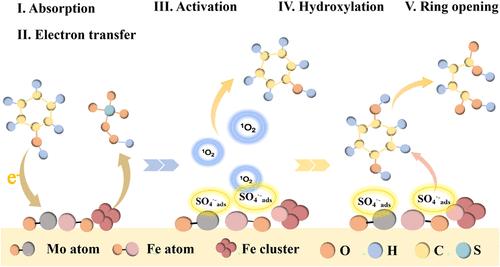Harnessing Fe–Mo Atomic Interfaces for Boosted Electron Transfer and ROS Generation in Sustainable Pollutant Degradation
IF 11.3
1区 环境科学与生态学
Q1 ENGINEERING, ENVIRONMENTAL
引用次数: 0
Abstract
Developing efficient and sustainable catalytic systems for persistent organic pollutant degradation remains a critical challenge in wastewater treatment. Herein, we present a novel FeMo0.5-OCN catalyst integrating iron clusters and molybdenum single atoms with oxygen coordination, which synergistically activates peroxymonosulfate (PMS) to generate reactive oxygen species (ROS), including sulfate radicals (SO4•–) and singlet oxygen (1O2), for enhanced pollutant degradation. Density functional theory (DFT) calculations and experimental studies reveal that Mo single atoms facilitate pollutant adsorption via oxygen coordination, while Fe clusters drive PMS activation, enabling efficient electron transfer and ROS generation. The FeMo0.5-OCN/PMS system achieves rapid degradation (>90% within 1 min) and high mineralization (73% TOC removal) of phenol, along with robust stability over 30 reaction cycles and broad pH adaptability (pH 2–11). Apart from phenol, this system demonstrates outstanding degradation efficiency for other phenolic contaminants as well. The practical applicability of the system is demonstrated by chemical oxygen demand (COD) removal efficiencies of 91, 44, and 33% for phenolic, high-salinity, and alcohol-containing wastewaters, respectively, outperforming conventional Fe2+/H2O2 systems and activated carbon treatments. Heterogeneous catalytic model quantifies the contribution of ROS and the mass transfer behaviors of pollutants at the solid–liquid interface. Sensitivity analysis confirms that the 1O2-facilitated generation of p-benzoquinone (p-BQ) is the rate-determining step in the overall reaction pathway. Life cycle assessment (LCA) confirms the system’s superior environmental sustainability and cost-effectiveness compared to conventional Fenton systems (Fe2+/H2O2 and Fe2+/PMS), with minimal metal leaching. This work highlights the critical role of interfacial electronic interactions in catalytic design and provides a scalable strategy for durable, eco-friendly wastewater remediation.

利用Fe-Mo原子界面促进电子转移和ROS生成在可持续污染物降解中
开发高效、可持续的降解持久性有机污染物的催化系统仍然是废水处理的关键挑战。在此,我们提出了一种新型的FeMo0.5-OCN催化剂,将铁簇和钼单原子与氧配位结合在一起,协同激活过氧单硫酸盐(PMS)产生活性氧(ROS),包括硫酸盐自由基(SO4•-)和单线态氧(1O2),以增强污染物的降解。密度泛函理论(DFT)计算和实验研究表明,Mo单原子通过氧配位促进污染物吸附,而Fe簇驱动PMS活化,实现高效的电子转移和ROS生成。FeMo0.5-OCN/PMS系统实现了苯酚的快速降解(1分钟内降解90%)和高矿化(73% TOC去除率),同时具有30个反应周期的稳定性和广泛的pH适应性(pH 2-11)。除苯酚外,该系统对其他酚类污染物也表现出出色的降解效率。该系统对酚类、高盐度和含醇废水的化学需氧量(COD)去除率分别为91%、44%和33%,优于传统的Fe2+/H2O2系统和活性炭处理。非均相催化模型量化了活性氧的贡献和污染物在固液界面的传质行为。敏感性分析证实,在整个反应途径中,o2催化生成对苯醌(p-BQ)是决定速率的步骤。生命周期评估(LCA)证实,与传统的Fenton系统(Fe2+/H2O2和Fe2+/PMS)相比,该系统具有更好的环境可持续性和成本效益,金属浸出最少。这项工作强调了界面电子相互作用在催化设计中的关键作用,并为持久、环保的废水修复提供了可扩展的策略。
本文章由计算机程序翻译,如有差异,请以英文原文为准。
求助全文
约1分钟内获得全文
求助全文
来源期刊

环境科学与技术
环境科学-工程:环境
CiteScore
17.50
自引率
9.60%
发文量
12359
审稿时长
2.8 months
期刊介绍:
Environmental Science & Technology (ES&T) is a co-sponsored academic and technical magazine by the Hubei Provincial Environmental Protection Bureau and the Hubei Provincial Academy of Environmental Sciences.
Environmental Science & Technology (ES&T) holds the status of Chinese core journals, scientific papers source journals of China, Chinese Science Citation Database source journals, and Chinese Academic Journal Comprehensive Evaluation Database source journals. This publication focuses on the academic field of environmental protection, featuring articles related to environmental protection and technical advancements.
 求助内容:
求助内容: 应助结果提醒方式:
应助结果提醒方式:


